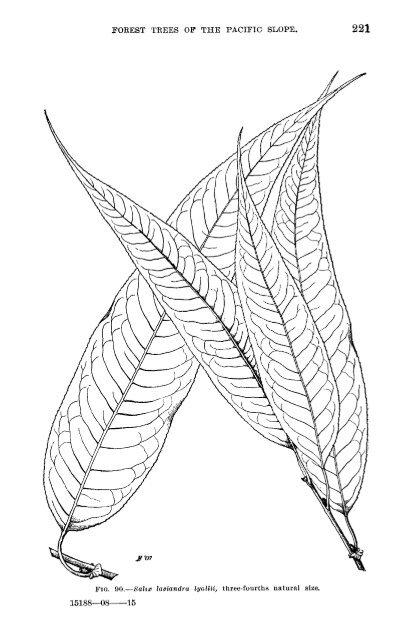De I. VNER VEW D Forest Trees of the Pacific Slope
De I. VNER VEW D Forest Trees of the Pacific Slope
De I. VNER VEW D Forest Trees of the Pacific Slope
Create successful ePaper yourself
Turn your PDF publications into a flip-book with our unique Google optimized e-Paper software.
FOREST TREES OF THE PACIFIC SLOPE.<br />
ing autumn <strong>the</strong>ir thin, closely-packed, overlapping scales gradually become<br />
loosened from <strong>the</strong>ir central spike-like axis and fall away with <strong>the</strong>ir winged<br />
seeds, two <strong>of</strong> which are borne under each scale; no fertile or perfect seeds are<br />
borne under scales at <strong>the</strong> ends <strong>of</strong> <strong>the</strong> cones. The pointed woody axes <strong>of</strong> <strong>the</strong><br />
cones remain attached to <strong>the</strong>ir branches for several years. The breaking up <strong>of</strong><br />
mature cones on <strong>the</strong> trees is not a character <strong>of</strong> any o<strong>the</strong>r group <strong>of</strong> our conebearers,<br />
<strong>the</strong> deciduous Taxodiums <strong>of</strong> south Atlantic forests excepted. Seeds <strong>of</strong><br />
firs are easily wafted by <strong>the</strong> wind several hundred feet from <strong>the</strong> parent trees,<br />
but <strong>the</strong>y are rarely carried more than 50 or 100 feet away. The seeds have<br />
peculiar resin cells which may be seen by cutting into <strong>the</strong> seed coat. The<br />
vitality <strong>of</strong> fir seeds does not endure beyond a single season, and as a rule <strong>the</strong><br />
percentage <strong>of</strong> germination is low (50 per cent or under). Seed-leaves, froni<br />
4 to 10, and flat.<br />
Commercially <strong>the</strong> firs are <strong>of</strong> great importance. Some <strong>of</strong> <strong>the</strong>m form protection<br />
forests on steep slopes at high elevations where few o<strong>the</strong>r conifers can<br />
live, while o<strong>the</strong>rs supply excellent saw-timber <strong>of</strong> large size. They are moderately<br />
long-lived, and 350 years is probably <strong>the</strong> limit <strong>of</strong> <strong>the</strong>ir age, but much is<br />
yet to be learned concerning <strong>the</strong> longevity <strong>of</strong> our firs.<br />
Seven species inhabit <strong>the</strong> <strong>Pacific</strong> forests; two <strong>of</strong> <strong>the</strong>m extend far northward<br />
into Canada, while one <strong>of</strong> <strong>the</strong>se and ano<strong>the</strong>r species range through <strong>the</strong> Rocky<br />
Mountains as well.<br />
Alpine Fir; Balsam Fir.<br />
Abies lasiocarpa (Hook.) Nuttall.<br />
DISTINGtJISIINOG CIIARACTERISTICS.<br />
Alpine fir is one <strong>of</strong> <strong>the</strong> smallest <strong>of</strong> <strong>the</strong> <strong>Pacific</strong> firs and perhaps also one <strong>of</strong> <strong>the</strong><br />
least known <strong>the</strong>re, owing to <strong>the</strong> high altitude at which it grows. Among all <strong>of</strong><br />
its associates <strong>the</strong> long, narrowly conical crown, terminating in a conspicuous<br />
spire-like point, at once distinguishes this fir from all species <strong>of</strong> its kind in<br />
<strong>the</strong> region. Its spear-like heads can be recognized at a long distance. Height.<br />
from 60 to 90 feet and diameter from 14 to 24 inches, but in exposed<br />
high situations it may be under 3 or 4 feet in height, with very long lower<br />
branches on <strong>the</strong> ground. Rare old trees attain heights <strong>of</strong> from 100 to 130 or,<br />
very occasionally, 160 feet and a diameter <strong>of</strong> 3 to 4 feet. Larger trees are<br />
reported, but <strong>the</strong>y are exceedingly rare. The bark is thin, at most about 11<br />
inches thick, hard, flinty, and but little broken on fairly large trees, except occasional<br />
shallow, narrow cracks near <strong>the</strong> base <strong>of</strong> <strong>the</strong> trunk. The unbroken smootn<br />
parts are ashy gray-<strong>of</strong>ten chalky-white. Even in old trunks, alvays irregularly<br />
and shallowly seamed, <strong>the</strong> flat ridges are whitish, but pale-brownish on <strong>the</strong><br />
broken edges and red-brown on <strong>the</strong> inside. <strong>Trees</strong> on several mountain peaks in<br />
Arizona, and occasionally elsewhere in <strong>the</strong> tree's range, have peculiarly thin,<br />
s<strong>of</strong>t, corky a bark, similar in color to <strong>the</strong> hard bark. The narrow crown usually<br />
extends to <strong>the</strong> ground, even on old trees. The dense branches, wvhich are characteristically<br />
tough, droop at <strong>the</strong> base <strong>of</strong> <strong>the</strong> crown ; when dead. <strong>of</strong>ten curved<br />
or bent down upon <strong>the</strong> trunk. Its low branches make it particularly susceptible<br />
to crown fires, which invariably kill it in large numbers, as do severe ground<br />
fires, which easily injure its thin bark. In very close stands old trees are occasionally<br />
free from branches for from 20 to 40 feet or more. The foilage is deep<br />
Abies arizonica Merriam is founded partly on this character and partly on a form <strong>of</strong><br />
cone-scale which Dr. Merriam found to differ materially from that <strong>of</strong> <strong>the</strong> ordinary type <strong>of</strong><br />
A. lasiocarpa. The cones and foliage <strong>of</strong> <strong>the</strong> cork-barked trees can not be distinguished by<br />
<strong>the</strong> writer from those <strong>of</strong> hard-barked trees.<br />
107

















